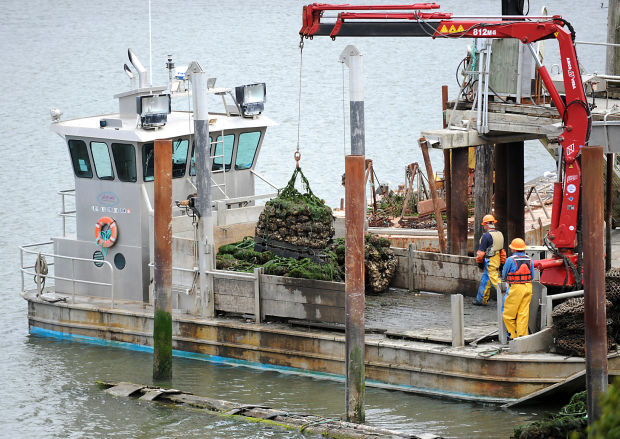Posted on Coos Bay World: 31 July 2013 — By Thomas Moriarty

By Alysha Beck, The World – Workers at Clausen Oysters in North Bend unload bags of seeded oyster shells gathered from Horsfall Beach on Tuesday. The oyster seed was taken back and spread out at Horsfall Wednesday morning.
COOS BAY — As a federal research vessel heads out to study the impact of ocean acidification on Pacific marine life, Oregon biologists are reporting both benign and negative impacts on regional shellfish.
The National Oceanic and Atmospheric Administration dispatched the R/V Fairweather from Seattle on Monday for a month-long cruise to collect water, plankton and algae samples. The agency is concerned that increasing ocean acidity levels attributed to greenhouse gas emissions are threatening marine ecosystems the fisheries they support.
The Oregon coast oyster industry has firsthand experience with the problem.
Several years ago, Netarts Bay’s Whiskey Creek Shellfish Hatchery — which produces much of the oyster seed used by commercial farms in the region — began experiencing a decline in production that Oregon State University researchers traced directly to ocean acidification.
But biologist Steve Rumrill said the future of the South Coast’s native oyster isn’t looking too bad.
“The short answer is that the native Olympia oysters may be doing OK and recovering in Coos Bay despite ocean acidification,” he said.
Rumrill, currently the director of Oregon Department of Fish and Wildlife shellfish monitoring program, was instrumental in Olympia oyster recovery efforts at the South Slough National Estuarine Research Reserve near Charleston.
“It may be that the shallow parts of Coos Bay may be able to act sort of as a buffer,” he said.
Oregon State University Professor George Waldbusser said said difference in survivability likely lies in the species’ reproductive practices.
“Olympias are brooders,” he said, referring to the species’ trait of carrying eggs in an internal chamber for several weeks after fertilization.
Pacific oysters, on the other hand, are broadcast spawners, meaning their eggs are fertilized and develop in open water.
Waldbusser said the native species’ reproductive period is on the edge of the coast’s seasonal upwelling cycle, when deep ocean currents force cold water to the surface.
Upwelling is believed to contribute to the acidification process by bringing oxygen-deprived, CO2-rich acidic water to the ocean’s surface.
As far as Rumrill’s buffer theory, the professor said one of his graduate students is also conducting research on increased production in seagrass habitat in Netarts Bay.
Waldbusser said any findings are likely six months out, at the earliest.
Reporter Thomas Moriarty can be reached at 541-269-1222, ext. 240, or by email at thomas.moriarty@theworldlink.com. Follow him on Twitter: @ThomasDMoriarty.